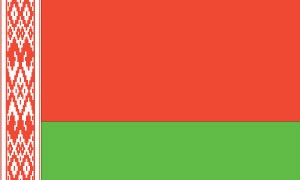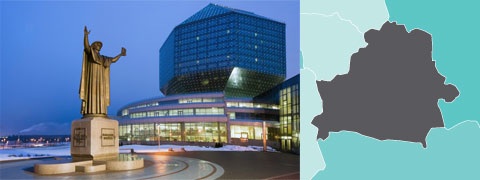Country assessments
Belarus
- Details
- Country assessments
2013 sector transition indicators
Source: EBRD.
Note: Water – Water and wastewater; IAOFS – Insurance and other financial services; PE – Private equity.
Highlights
- The macroeconomic situation deteriorated once again, as the external environment worsened and monetary and fiscal policies were loosened. Output growth has remained slow, as external and domestic demand contracted. Low central bank reserves, limited access to external funding and the recent rapid build-up of foreign currency loans in the banking system are all significant potential sources of instability.
- The privatisation process remained stalled and some privatisations were reversed. The government took over ownership of two previously privatised enterprises, and is contemplating legislation that would allow government representatives to influence the decisions of privatised enterprises on behalf of the minority shareholders.
- The commercial sector continued to be dominated by the state-owned banks, and directed lending increased. In addition to taking over some of the stock of the previously accumulated directed loans from other banks’ balance sheets, the newly created Development Bank has engaged in new directed lending operations.
Key priorities for 2014
- It is important to establish a macroeconomic policy framework aimed at reducing volatility. The central bank (the National Bank of the Republic of Belarus) should be charged primarily with stabilising inflation, maintaining a flexible exchange rate and continuing to pursue policies to limit dollarisation of the financial system. Wage growth should reflect productivity developments, and the use of output targets should be phased out.
- Deep institutional reforms are needed to encourage private sector development. Non-strategic enterprises should be privatised and new private owners should be allowed to manage them on a commercial basis. The state-owned banks should progressively increase the proportion of loans offered on a commercial basis, and directed lending should be reduced.
- The authorities should reform municipal infrastructure, and increase the incentives for greater energy efficiency. Cost recovery of municipal tariffs paid by households should be increased, and municipal infrastructure should be run on the principles of cost recovery. Incentives for improving energy efficiency need to be strengthened through market pricing of energy and the establishment of a clear framework for renewable energy.
Macroeconomic performance
The post-crisis economic recovery has lost momentum. Industrial production slowed due to falling external demand and deteriorating terms of trade. Domestic investment and construction had to be curtailed, as the government cut back on the direct investment programmes. Domestic consumption stabilised after increasing rapidly following the significant public wage increases implemented before the 2012 parliamentary elections. External risks re-emerged, as the current account deficit increased sharply in the first half of 2013, to 8.5 per cent of GDP, driven by the widening trade deficit. External financial support declined and the Russian authorities closed loopholes that had allowed Belarus to generate windfall hydrocarbon revenues from refined oil. Following several administrative price increases and central bank interest rate cuts (cumulatively by 650 basis points since the beginning of 2013, to 23.5 per cent at end-August 2013), inflationary pressure has remained strong.
The likelihood of another bout of macroeconomic instability has increased. As the government has pursued ambitious growth targets through looser monetary policy and higher directed lending, and the pace of wage growth has outstripped productivity growth, external pressures have intensified. The recent dissolution of a joint venture between Belaruskali and Russia’s Uralkali is likely to lead to a reduction of potash export revenues – which is one of the country’s main sources of foreign exchange – as well as to aggravate relations with Russia, which is a key source of financial support. Even after the penultimate tranche of the US$ 3 billion loan by the Eurasian Economic Community’s stabilisation fund was disbursed, gross international reserves of the central bank continued to hover around a level equivalent to just two months of imports. Since late 2012 the Ministry of Finance has been issuing foreign currency-denominated bonds to financial institutions and households, which the central bank exempted from reserve requirements and included among the collateral eligible for refinancing. The government has also considered introducing tighter capital controls to prevent outflows. However, as the experience of 2011 demonstrated, these measures are unlikely to be sufficient to prevent future adjustment should the external environment deteriorate further and the authorities are unable to tap external lifelines.
Considerable changes to the country’s economic model are needed to secure sustainable growth. The existing model, based on full employment primarily in the state-controlled sector, leaves little room for reallocation of capital and labour to new, more productive sectors of the economy. At the same time, open borders with Russia in the context of the Eurasian Customs Union, as well as higher average incomes in Russia, are encouraging considerable labour outflows. In the longer term the government’s ability to encourage domestic investment and consumption will be limited, as public debt has been trending upwards, while international reserves have remained low. Structural reforms that would enable labour migration to new sectors, including through privatisation and private sector development, are much needed.
Major structural reform developments
The government maintained firm price controls, but also took some steps to encourage private sector development. The list of goods and services subject to price controls by the state has remained in effect since February 2011. In January 2013 the government introduced new requirements on mechanisms for justifying prices and mark-ups by producers. Although utility prices were raised several times throughout 2013, they continue to cover only a fraction of production costs. In January 2013 the new Bankruptcy Law came into effect, which is expected to simplify and streamline bankruptcy procedures and eliminate various loopholes, ultimately leading to an improvement in the investment climate. The responsibility for managing the Entrepreneurship Fund was transferred to the Ministry of Economy, and the fund was recapitalised. If this fund is run on a commercial basis – as is intended by the Ministry – the fund should, over time, help encourage the development of small and medium-sized enterprises throughout the country. In August 2013 the parliament adopted the Law on Investments, which should clarify investor rights and procedures for the resolution of disputes involving the state.
The privatisation process has stalled and some privatisation agreements were reversed. The sale of Orshansky Aircraft Repair Plant to the Ukrainian engines manufacturer, Motor Sich, in January 2012 remained the only privatisation in almost two years. The National Agency of Investment and Privatization was able to reach the negotiation stage in the proposed privatisation of two companies – the Minsk margarine factory and the confectionary producer, Konfa – of the eight that were included in a pilot privatisation scheme. At the same time, the government continued reorganising its equity stakes in various state enterprises into holdings, including for meat and milk processing, microelectronics, road construction and truck building. In October 2012 two previously privatised confectionary companies were taken over by the state, as was a footwear factory, in April 2013. A draft law that would grant the government the authority to exercise control on behalf of small shareholders in previously privatised companies was adopted on its first reading, in June 2013, and is currently undergoing further consultations.
The state-owned financial institutions continued to dominate the banking sector. As of April 2013 Belarusian state banks controlled approximately two-thirds of the total assets in the banking system. The Development Bank of the Republic of Belarus – originally created to absorb existing directed loan portfolios from other state banks – also began conducting directed lending operations. In August 2013 several amendments to legislation were adopted, expanding the list of the Development Bank’s potential operations. Banking supervision was strengthened, as several changes to the Banking Code came into effect in January 2013, including measures to improve central bank governance and transparency and monitoring of financial risks, as well as stricter licensing, governance and risk management requirements for commercial banks. The most important changes included the mandatory requirement to nominate independent members to banks’ supervisory boards and audit committees, the establishment of risk manager positions, and requirements to improve the transparency of bank ownership structures. In 2013 the authorities also embarked on a campaign to curb the boom in foreign currency lending (as foreign currency loans increased by 50 per cent year-on-year in June 2013) by tightening reserve requirements and applying higher risk weights for such loans. These new requirements were effective from October 2013.
The authorities engaged in large investment projects with Russia and China. In July 2013 Belarus signed more than 30 contracts with China on joint projects aimed at attracting Chinese investments to the country and in upgrading Belarusian infrastructure. The most prominent projects include the creation of an industrial park near Minsk to host several high-tech Chinese companies, a joint car assembly venture with Zheijing Geely Holding Group, which is expected to produce up to 120,000 vehicles per year, a loan to finance the connection of the new nuclear power plant to the power grid, and several projects in the railway and financial sectors. The authorities are preparing to establish a joint venture between Belarus’ MAZ and Russia’s KamAZ truck manufacturers, which is expected to be finalised in the autumn of 2013. Various projects in the energy sector – involving Russia’s Gazprom – and in the chemicals and machinery sectors are under consideration.













